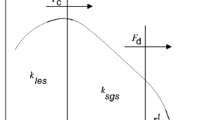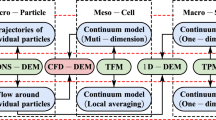Abstract
Air flow inside an array of cubes is simulated. Cubes (edge length 0.15 m) are arranged in a regular array, separated by 0.15 m in the streamwise and spanwise directions. Numerical simulations are performed based on Reynolds-averaged Navier–Stokes equations (RANS), solved in a computational fluid dynamics model (CFD), with standard k–ε turbulent closure (two prognostic equations are solved for the turbulent kinetic energy k and its dissipation ε, respectively). Simulations are validated against wind-tunnel data using a technique based on hit-rate calculations, and calculated statistical parameters. The results show that the horizontal velocity is very well modelled, and despite some discrepancies, the model that fulfils the hit-rate test criteria gives useful results that are used to investigate three-dimensional (3-D) flow structures. The 3-D analysis of the flow shows interesting patterns: the centre of the canyon vortex is at 3/4 of the canyon height, and stronger downward than upward motions are present within the canyon. Such behaviour is explained by the presence of a compensation flow through the side of the canyon, which enters the canyon from the upper part and exits from the lower part. This complex 3-D structure affects the tracer dispersion, and is responsible for pollutant transport and diffusion.
Similar content being viewed by others
References
Assimakopoulos VD, ApSimon HM, Moussiopoulos N (2003) A numerical study of atmospheric pollutant dispersion in different two-dimensional street canyon configurations. Atmos Environ 37:4037–4049
Baik J-J, Kim J-J (1999) A numerical study of flow and pollutant dispersion characteristics in urban street canyons. J Appl Meteorol 38:1576–1589
Brown MJ, Lawson RE, Decroix DS, Lee RL (1999) Mean flow and turbulence measurements around a 2-D array of buildings in a wind tunnel, Report LA-UR-99-5395, Los Alamos National Laboratory, Los Alamos, NM, 7 pp
Brown MJ, Lawson RE, DeCroix DS, Lee RL (2001) Comparison of centerline velocity measurements obtained around 2D and 3D buildings arrays in a wind tunnel, Report LA-UR-01-4138, Los Alamos National Laboratory, Los Alamos, 7 pp
Chan AT, Au WTW, So ESP (2003) Strategic guidelines for street canyon geometry to achieve sustainable street air quality-part II: multiple canopies and canyons. Atmos Environ 37:2761–2772
Chan TL, Dong G, Leung CW, Cheung CS, Hung WT (2002) Validation of a two dimensional pollutant dispersion model in an isolated street canyon. Atmos Environ 36:861–872
Cheng Y, Lien FS, Yee E, Sinclair R (2003) A comparison of large Eddy simulations with a standard k–ε Reynolds-averaged Navier–Stokes model for the prediction of a fully developed turbulent flow over a amtrix of cubes. J Wind Eng Indust Aero 91:1301–1328
Eichhorn J (2004) Application of a new evaluation guideline for microscale flow models. In: 9th International Conference on Harmonisation within Atmospheric Dispersion Modelling for Regulatory Purposes, Garmisch-Partenkirchen, June 1–4, Germany, 5 pp
Fluent Inc (2005) FLUENT 6.2 user’s guide, volumes 1–3, Fluent Inc., Lebanon, 2216 pp
Garcia-Sagrado AP, van Beck J, Rambaud P, Olivari O (2002) Numerical and experimental modelling of pollutant dispersion in a street canyon. J Wind Eng Indust Aero 90:321–339
Gerdes F, Olivari D (1999) Analysis of pollutant dispersion in an urban street canyon. J Wind Eng Indust Aero 82:105–124
Gidhagen L, Johansson C, Langner J, Olivares G (2004) Simulation of NO x and ultrafine particles in a street canyon in Stockholm, Sweden. Atmos Environ 38:2029–2044
Grawe D, Schlünzen KH, Pascheke F (2004) Comparison of results of an obstacle resolving numerical model with wind tunnel data. In: 9th International conference on harmonisation within atmospheric dispersion modelling for regulatory purposes, Garmisch-Partenkirchen, June 1–4, Germany, 5 pp
Hanna SR, Strimaitis DG, Chang JC (1991) Hazard response modelling uncertainty (a quantitative method) Volume II. Evaluation of commonly-used hazardous gas dispersion model, Report F08635-89-C-0136, Sigma Research Corporation, Air Force Engineering and Service Center, Tyndal Air Force Base, Florida, 338 pp
Hoydysh WG, Griffiths RA, Ogawa Y (1974) A scale model study of the dispersion of pollution in street canyons. In: 67th annual meeting of the air pollution control association, Denver, Colorado, paper no. 74–157, 26 pp
Kastner-Klein P, Plate EJ (1999) Wind tunnel study of concentration fields in street canyons. Atmos Environ 33:3973–3979
Launder BE, Spalding DB (1974) The numerical computation of turbulent flow. Method Appl Mech Eng 3:269–289
Leonard BP (1979) A stable and accurate convective modelling procedure based on quadratic upstream interpolation. Comp Meth Appl Mech Eng 19:59–98
Lien F-S, Yee E (2004) Numerical modelling of the turbulence flow developing within and over a 3-D building array, part I: A high-resolution Reynolds-averaged Navier–Stokes approach. Boundary-Layer Meteorol 112:427–466
Martilli A, Santiago JL (2007) CFD simulation of airflow over a regular array of cubes. Part II: Analysis of Spatial Average Properties. Boundary-Layer Meteorol 122 (this issue)
Meroney RN, Pavegeau M, Rafailidis S, Schatzmann M (1996) Study of line source characteristics for 2-D physical modelling of pollutant dispersion in street canyons. J Wind Eng Indust Aero 62:37–56
Pascheke F, Leitl B, Schatzmann M (2005) Dispersion of traffic pollutants in street canyons –systematic wind tunnel study to evaluate a field tracer experiment. In: 5th international conference on urban air quality, Valencia, March 29–31, Spain, 4 pp
Patankar SV (1980) Numerical heat transfer and fluid flow. Hemisphere Publishing Corporation, New York, 197 pp
Sabatino SD, Buccolieri R, Pulvirenti B, Britter R (2005) Flow and pollutant dispersion modelling in street canyons using FLUENT and ADMS-URBAN. In: 5th international conference on urban air quality, Valencia, March 29–31, Spain, 4 pp
Santiago JL, Martin F (2005) Modelling the air flow in symmetric and asymmetric street canyons. Int J Environ Pollut 25:145–154
Santiago JL, Sanz-Andres A, Martin F (2005) Experimental and numerical study of a type of windbreaks to reduce dust emissions in harbours. In: 1st international conference on harbours & air quality, Genoa, June 15–17, Italy, 8 pp
Schlünzen KH, Bächlin W, Brünger H, Eichhorn J, Grawe D, Schenk R, Winkler C (2004) An evaluation guideline for prognostic microscale wind field models. In: 9th international conference on harmonisation within atmospheric dispersion modelling for regulatory purposes, Garmisch-Partenkirchen, June 1–4, Germany, 4 pp
Schlünzen KH, Bächlin W, Brünger H, Eichhorn J, Grawe D, Schenk R, Winkler C (2005) A guideline for evaluating micro-scale wind filed models. In: 5th international conference on urban air quality, Valencia, March 29–31, Spain, 4 pp
Sini J-F, Anquetin S, Mestayer PG (1996) Pollutant dispersion and thermal effects in urban street canyons. Atmos Environ 30:2659–2677
Snyder W (1981) Guideline for fluid modelling of atmospheric diffusion, report No EPA-600/8-81-009, US Environmental Protection Agency, Research Triangle Park, NC, 200 pp
Vachon G, Louka P, Rosant J-M, Mestayer P, Sini J-F (2001) Measurements of traffic-induced turbulence within a street canyon during the Nantes 99 experiment. In: Third international conference on urban air quality, Loutraki, March 19–23, Greece, 4 pp
Versteeg HK, Malalasekera W (1995) An introduction to computational fluid dynamics. The finite volume method. Pearson Prentice Hall, Harlow, 272 pp
Wilks DS (1995) Statistical methods in atmospheric sciences. Academic Press, San Diego, 464 pp
Author information
Authors and Affiliations
Corresponding author
Rights and permissions
About this article
Cite this article
Santiago, J.L., Martilli, A. & Martín, F. CFD simulation of airflow over a regular array of cubes. Part I: Three-dimensional simulation of the flow and validation with wind-tunnel measurements. Boundary-Layer Meteorol 122, 609–634 (2007). https://doi.org/10.1007/s10546-006-9123-z
Received:
Accepted:
Published:
Issue Date:
DOI: https://doi.org/10.1007/s10546-006-9123-z




